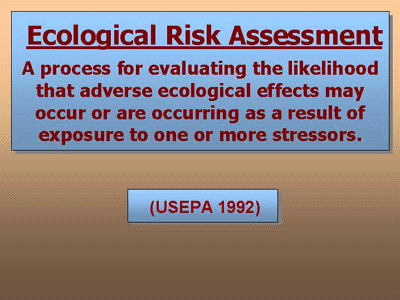Using Ecological Risk Assessment in Watershed Management
Watershed managers need a process for determining which ecological features in the watershed are at risk and choosing the best actions to protect them. Ecological risk assessment is a process to collect, organize, analyze and present scientific information to optimize its use in decision making. This is accomplished by evaluating the likelihood that adverse ecological effects may occur or are occurring as a result of exposure to one or more stressors. The process also brings together scientists and decision-makers so that scientists can better focus on needs of the decision-makers while helping them better understand the ecological implications of their actions. Risk assessment provides a basis for comparing, ranking and prioritizing risks, and estimating ecological effects as a function of exposure to stress in the watershed.
Comments from a review of five pilot watershed risk assessments (Eastern Research Group 1998) indicated that, although watershed risk assessment was a new application of ecorisk methods, the following points appear promising:
- watershed management can benefit from the use of the formal, scientifically defensible methods of risk assessment;
- the ecological risk assessment process helps people to carefully examine what led them to their conclusions and document their findings; and
- the risk assessment framework can add value to watershed-based management programs, particularly when addressing problems caused by multiple and non-chemical stressors.
Ecological risk assessment methods can be particularly useful in evaluating whether uses are threatened when a stressor of concern is not expressed as a numeric criterion in Water Quality Standards. For instance, is a fish population at risk due to increasing sediment load, although Standards may not address this? The methods are also very useful for evaluating the relative importance of multiple potential stressors. This may help determine if it is primarily the sediment load, increased temperature, degraded channel conditions, or a combination of all three that is impairing the fishery.
A sound scientific approach is not without cost, however, and the methods of risk assessment are not for all situations. Many communities do not have the financial resources, technical expertise or necessary data to conduct a comprehensive watershed risk assessment. Yet, they can still follow risk assessment principles for better insights on what monitoring data to collect, or how to organize or present their data. In complex systems such as watersheds, and when funds and time are limited, completing the risk assessment planning and problem formulation may yield an effective stand-alone product without continuing further.
![[logo] US EPA](https://www.epa.gov/epafiles/images/logo_epaseal.gif)
